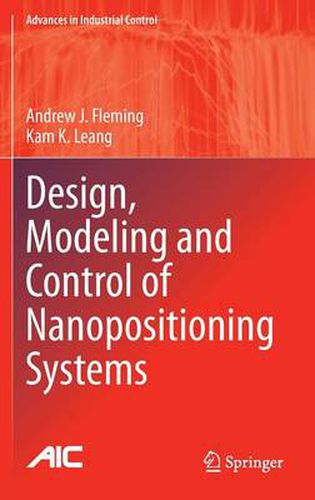Readings Newsletter
Become a Readings Member to make your shopping experience even easier.
Sign in or sign up for free!
You’re not far away from qualifying for FREE standard shipping within Australia
You’ve qualified for FREE standard shipping within Australia
The cart is loading…






This title is printed to order. This book may have been self-published. If so, we cannot guarantee the quality of the content. In the main most books will have gone through the editing process however some may not. We therefore suggest that you be aware of this before ordering this book. If in doubt check either the author or publisher’s details as we are unable to accept any returns unless they are faulty. Please contact us if you have any questions.
Covering the complete design cycle of nanopositioning systems, this is the first comprehensive text on the topic. The book first introduces concepts associated with nanopositioning stages and outlines their application in such tasks as scanning probe microscopy, nanofabrication, data storage, cell surgery and precision optics. Piezoelectric transducers, employed ubiquitously in nanopositioning applications are then discussed in detail including practical considerations and constraints on transducer response. The reader is then given an overview of the types of nanopositioner before the text turns to the in-depth coverage of mechanical design including flexures, materials, manufacturing techniques, and electronics. This process is illustrated by the example of a high-speed serial-kinematic nanopositioner. Position sensors are then catalogued and described and the text then focuses on control.
Several forms of control are treated: shunt control, feedback control, force feedback control and feedforward control (including an appreciation of iterative learning control). Performance issues are given importance as are problems limiting that performance such as hysteresis and noise which arise in the treatment of control and are then given chapter-length attention in their own right. The reader also learns about cost functions and other issues involved in command shaping, charge drives and electrical considerations. All concepts are demonstrated experimentally including by direct application to atomic force microscope imaging.
Design, Modeling and Control of Nanopositioning Systems will be of interest to researchers in mechatronics generally and in control applied to atomic force microscopy and other nanopositioning applications. Microscope developers and mechanical designers of nanopositioning devices will find the text essential reading.
$9.00 standard shipping within Australia
FREE standard shipping within Australia for orders over $100.00
Express & International shipping calculated at checkout
Stock availability can be subject to change without notice. We recommend calling the shop or contacting our online team to check availability of low stock items. Please see our Shopping Online page for more details.
This title is printed to order. This book may have been self-published. If so, we cannot guarantee the quality of the content. In the main most books will have gone through the editing process however some may not. We therefore suggest that you be aware of this before ordering this book. If in doubt check either the author or publisher’s details as we are unable to accept any returns unless they are faulty. Please contact us if you have any questions.
Covering the complete design cycle of nanopositioning systems, this is the first comprehensive text on the topic. The book first introduces concepts associated with nanopositioning stages and outlines their application in such tasks as scanning probe microscopy, nanofabrication, data storage, cell surgery and precision optics. Piezoelectric transducers, employed ubiquitously in nanopositioning applications are then discussed in detail including practical considerations and constraints on transducer response. The reader is then given an overview of the types of nanopositioner before the text turns to the in-depth coverage of mechanical design including flexures, materials, manufacturing techniques, and electronics. This process is illustrated by the example of a high-speed serial-kinematic nanopositioner. Position sensors are then catalogued and described and the text then focuses on control.
Several forms of control are treated: shunt control, feedback control, force feedback control and feedforward control (including an appreciation of iterative learning control). Performance issues are given importance as are problems limiting that performance such as hysteresis and noise which arise in the treatment of control and are then given chapter-length attention in their own right. The reader also learns about cost functions and other issues involved in command shaping, charge drives and electrical considerations. All concepts are demonstrated experimentally including by direct application to atomic force microscope imaging.
Design, Modeling and Control of Nanopositioning Systems will be of interest to researchers in mechatronics generally and in control applied to atomic force microscopy and other nanopositioning applications. Microscope developers and mechanical designers of nanopositioning devices will find the text essential reading.